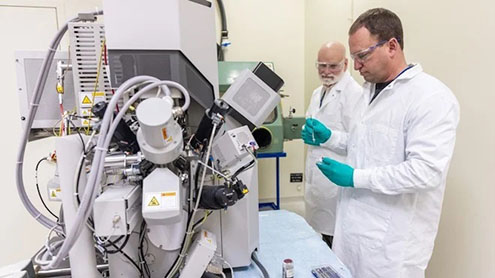COLUMBIA, Mo. — For more than 50 years, the University of Missouri has developed a reputation as a worldwide leader in nuclear science and engineering research at the MU Researcher Reactor (MURR), the nation’s highest-powered university research reactor.

Building on MURR’s internationally recognized level of excellence, the university is looking into the future by adding a scanning electron microscope (SEM) to the facility’s research equipment. This new tool can help researchers make new discoveries in materials science. It also places MU on a small, prominent list of academic and government facilities, such as the Department of Energy’s Oak Ridge and Idaho National Laboratories, which have similar types of diagnostic tools available for research purposes in radiation environments.
Scientists will be able to use the SEM to characterize materials such as steel or nickel alloys after irradiation in MURR. This knowledge can help engineers select the optimal building materials when developing the next generation of commercial nuclear power plants across the United States. Since 1990, nuclear power plants have generated at least 20% of the total electrical energy used annually in the U.S. according to the U.S. Energy Information Administration.
“In many different engineering fields, the limiting factor of performance often ends up being how materials respond to their environments,” said John Gahl, professor in the College of Engineering and senior research scientist at MURR. “Here, we’re helping build the knowledge base for materials that can be used in a nuclear energy environment by providing the information needed to make data-informed decisions.”
The SEM will also allow researchers to determine how a material responds in an environment where it’s exposed to radiation, such as inside a nuclear power plant.
“We can test reactor component materials in a macro way, such as on a load frame, and also characterize them on a micro level with the SEM,” Gahl said. “This allows us to examine the structure before and after irradiation, to look for changes in the material’s structure and to determine how materials performance may be affected.”
Gahl believes the technology will help generate new collaborations among researchers at MU and beyond.
University of Missouri Research Reactor
The work at the University of Missouri Research Reactor (MURR) improves and saves lives every day. MURR’s innovative design and year-round operating cycle enables it to produce the active pharmaceutical ingredients in multiple FDA-approved drugs. More than 1.6 million patients last year were diagnosed or treated using the radioisotopes that MURR produces. Because of MURR’s unique capabilities, it is a vital resource for cancer patients, health care providers, researchers and industrial partners in Missouri and around the globe. MU’s initiative to build a new, state-of-the art reactor — NextGen MURR – will expand the university’s critical cancer-fighting research and medical isotope production, creating an innovation hub for nuclear medicine.
